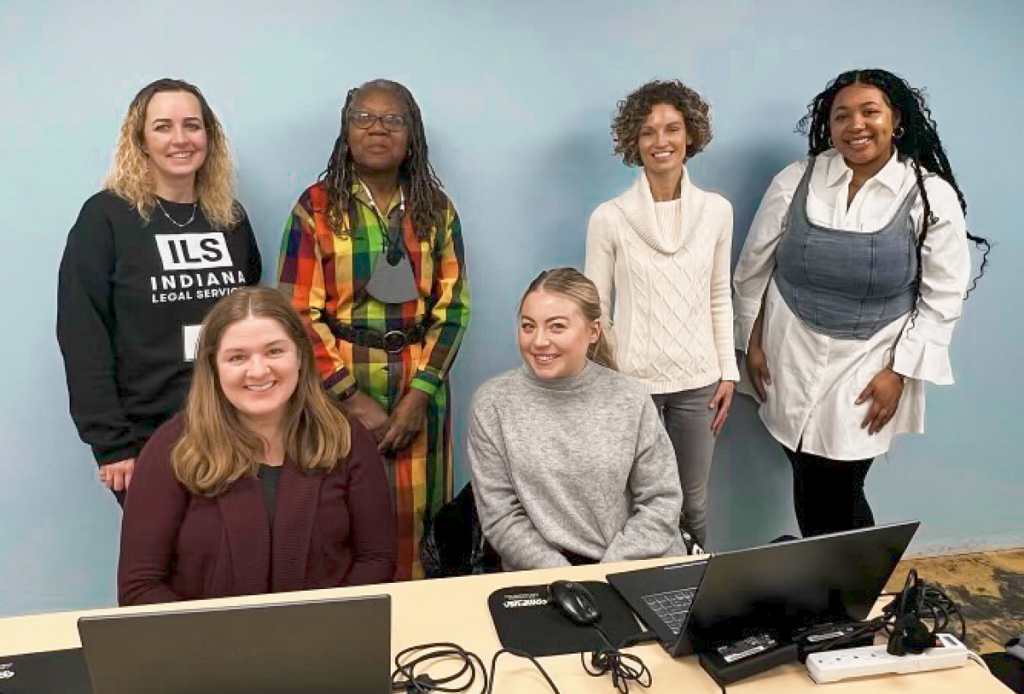Subscriber Benefit
As a subscriber you can listen to articles at work, in the car, or while you work out. Subscribe NowWith eviction filings showing no signs of slowing down with the start of a new year, Indiana Legal Services has continued to help Hoosier tenants with their efforts to seal prior evictions that could prevent them from finding new housing.

At a Jan. 12 eviction sealing clinic in Center Township, ILS saw 140 clients with approximately 400 eviction pleadings, according to ILS Pro Bono Project Director Jeff Heck.
“It’s the largest one we’ve done to date in the city,” Heck told Indiana Lawyer.
The idea of holding eviction sealing clinics came after the Indiana General Assembly in 2022 passed a bill designed to help tenants.
House Enrolled Act 1214 allowed tenants to seal their eviction records in certain circumstances. A court can seal an eviction record if an eviction petition is dismissed or a judgment is entered in favor of a tenant.
Nick Minaudo, a staff attorney for ILS’ Bloomington office, said the ILS clinics started ramping up in 2022 and got a boost from Indiana Bar Foundation funding.
The ILS Monroe County office is holding its own eviction sealing clinic from 1-3 p.m. on Feb. 15.
Minaudo said the clinic in Monroe County is a little different than some of the other ones held around the state, with local judges allowing the county courthouse to be used for the event.
He said the last Monroe County eviction sealing clinic was held in October, with around 10-12 people showing up with 15 filings. But it’s hard to gauge, county-by-county among the Monroe County office’s 14-county service area, whether eviction filings are trending higher or lower heading into 2024.
“We’re hoping to do more this time,” Minaudo said, adding, “I would love to have the success that Jeff’s clinic did.”
Under seal
According to ILS, at the clinics, clients meet with an attorney who will fill out the paperwork necessary for their evictions to be sealed.
ILS may also be able to assist clients with e-filing the documents at the clinic, or give them written instructions on how to file the paperwork with the court and serve their previous landlord.
The decision to seal each eviction is ultimately up to the judge of the court in which the eviction is filed, and an eviction cannot be expunged if a tenant still owes money for the eviction.
Heck said there are many people who show up at the free clinics and have multiple eviction filings they are looking to seal. He said clients average about three-to-four eviction filings at the clinics, with one client having more than 20.
But Heck explained that in cases like that particular one, it doesn’t mean the client was displaced from their housing every time there was an eviction filing.
Sometimes, a tenant will get late on rent in a given month and a landlord will automatically file an eviction notice after the second or third day the rent is late. The tenant will pay the late rent, not be displaced and the case is dismissed, Heck explained, but the eviction filing is still on record.
If that tenant then tries to move to a new apartment or rental unit and a prospective landlord sees 20 or more eviction filings on a background check, it makes it exceedingly difficult to find new housing, he added.
At ILS’ first eviction sealing clinic at the Lawrence Township Small Claims Court, there was a line around the block, with people waiting to speak with a pro bono or ILS staff attorney, Heck acknowledged.
“We greatly underestimated the demand for these things,” he said.
Minaudo said he views it in the context of the more people who come through the clinics, the more chances ILS has to potentially provide housing relief for them.
Tracking the numbers
According to Heck, ILS typically gets 12-15 attorneys working pro bono at the clinics, with usually three staff attorneys on hand to assist tenants.
Minaudo said his office has been hearing anecdotally that eviction filings are approaching pre-pandemic levels.

Marc McAleavey, The Polis Center’s community analysis program manager, said recent Eviction Lab data showed there were 1,681 eviction filings in Indianapolis in December and 2,093 in November. For all of 2023, there were 27,244 filings in the Indianapolis area.
Statewide, there were 73,146 eviction filings in 2023, with 4,801 in December and 5,440 in November.
Comparatively, there were 50,505 eviction filings in Indiana in 2021 and 68,882 in 2022.
Also, there were 19,996 eviction judgments statewide in 2021, with that number rising to 27,680 in 2022.
SAVI, a program of The Polis Center, a research unit in the Indiana University Luddy School of Informatics, Computing, and Engineering at Indianapolis, hosted an event Dec. 7 where a new dashboard was unveiled that gives people a look at comprehensive statewide eviction data and provides information that can be used to address housing issues.

The dashboard has maps, eviction trends and some demographic data. The goal of the tool is to raise awareness about evictions in Indiana and provide a resource to empower communities to create change.
Work on the dashboard began in March 2023, with eviction data coming from the Indiana Supreme Court and demographic information taken from the U.S. Census and American Community Survey.
McAleavey said the Dec. 7 event drew more than 200 registrants. Event organizers went over the dashboard’s features and held panel discussions on evictions and what the data is showing.
“It’s really hard to scientifically predict what the year will bring, in terms of evictions,” he said said.
McAleavey said he has seen an increased willingness from all sides, including philanthropists, tenant advocates and apartment companies, to find grassroot solutions to an issue that affects thousands of residents statewide.
“It blows my mind how many Hoosiers become unhoused every day because of this issue,” he said.•
Please enable JavaScript to view this content.

